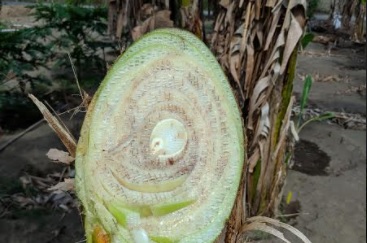
Together with a research team of the Faculty of Agriculture, UGM plant disease expert Professor Siti Subandiyah investigated the application of omics technologies to control the prevalent blood disease of bananas in Indonesia. As one of the world’s largest banana producers, Indonesia faces a threat of declined productivity due to blood disease. National production, which averages seven million tons each year, may find potential crop-failure losses of more than 20%-50% if the infection does spread to the entire archipelago.
Banana blood disease (BDB) is a bacterial infectious disease that attacks bananas, especially those used as raw material for processed banana products, which causes the flesh of bananas to rot and turn brown (discoloration) and the leaves to wither. In addition, the symptoms include the release of blood-like reddish sap on the stem or decay indicated by reddish-brown lines on the heart, bunch, or stems when the infected plant is cut and split vertically. The culprit of the disease is Ralstonia syzygii subsp. celebesensis (Rsc), and kepok or saba banana is the type that usually contracts the infection.
“Banana blood disease is still a scourge in the banana industry because to date, proper and fast control methods remain undiscovered,” said Siti on Friday (6/8).
With omics technologies, she continued, researchers could conduct molecular identification of the said bacterium using a specific primer nucleotide sequence for PCR (polymerase chain reaction). The method also helped her team to carry out in-depth identification of the Rsc isolate under the code UGMSS-Db01 using WGS (whole genome sequencing).
The professor added omics analysis produced results that were crucial and fundamental to the development of agricultural biotechnology. Together, omics and biotechnology contribute to a potential increase in food production, food security realization, and improvement in genomic analysis underlying disease diagnosis, molecular identification, or pathogen detection. It is worth noting that diagnosis or identification of disease-causing pathogens is pivotal to determine control techniques for the said disease.
Omics technologies also helped researchers create genetically engineered disease-resistant plants. Although for the latter, it is more complicated because transgenic plants require a large sum of money in the making and are only applicable to plants of high economic value with the associated disease. Genetically modified plants must also take food-safe, feed-safe, and environmentally safe certifications before being planted for commercial purposes as stipulated in the Government Regulation.
“Omics studies help discover precise and scientifically justifiable solutions. This technique will underlie the accuracy of target gene selection for transgenic plants or gene editing to develop BDB-resistant bananas and the development of environmentally friendly molecular bio fungicides based on micro Ribonucleic Acid (RNA),” explained Siti.
Author: Ika

